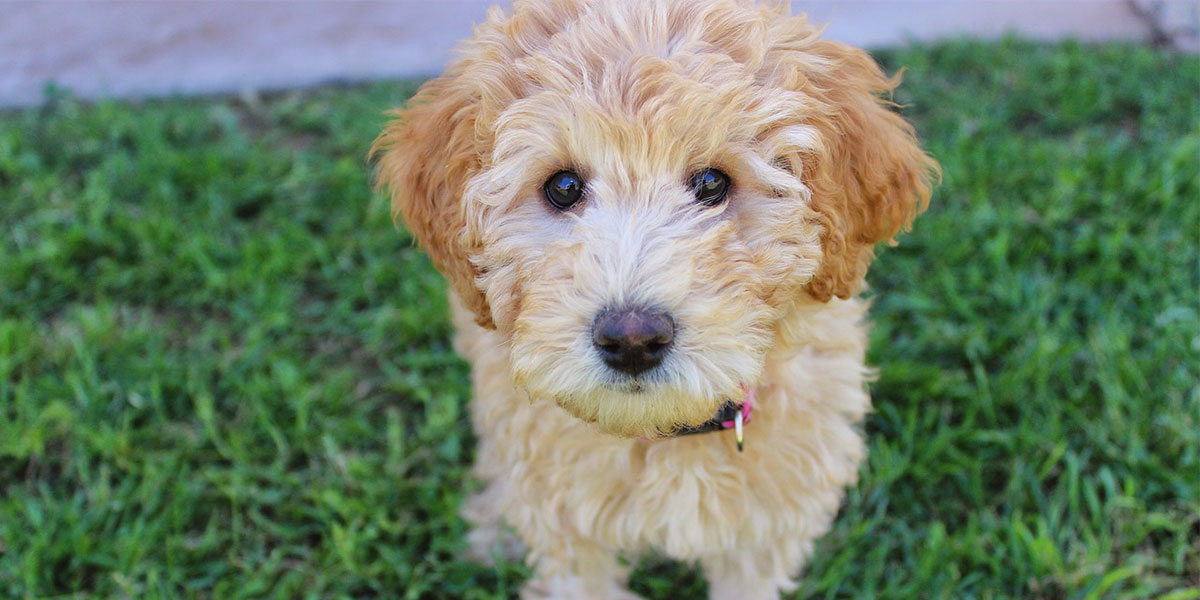Taking too long? Close loading screen.

January 18th
Wondering when, what and how to feed your new Doodle puppy? Look no further.
Owners ask us all the time which human food is OK for their dog to eat and which isn’t. We’ll get into all that in a jiffy, but first…
If you’re at home, we recommend free water and food, while removing your pup’s food and water at least one hour (but preferably two) before crating your dog at night. Before crating your Doodle, let him or her out to use the bathroom—your dog’s bladder should always be emptied before being left in the crate.
Our breeders feed our dogs twice a day using a mix of 1 cup dry food and ½ cup wet food. We leave dry food available to the pups in between their two main feedings, and fresh water available at all times.
People are often amazed at just how much puppies can (and should) eat. If your Doodle pup seems hungry, odds are pretty good that they are. Doodles are not known as over-eaters, so don’t hesitate to feed your pup until they’re satisfied—unless weight is already an issue.
Growing Doodle pups can actually eat more than adult Doodles, so don’t be surprised by your pup’s appetite. Young animals of virtually any species have higher caloric needs than adults, and should likewise consume foods with higher fat content.
With that being said, it’s not impossible to see an obese Doodle pup. It’s just really unlikely.
Some people are so terrified of giving their dogs “human” food that the sight of their pooch rooting through the trash is enough to cause heart palpitations.
The fact is that dogs were originally domesticated from wolves as they ate alongside their new human pack members—and early humans didn’t exactly have the luxury of buying dry or canned wolf food from the supermarket.
Of course, dogs and wolves have very different diets today. There are absolutely some foods that agree with your pooch’s digestive system, and some that don’t.
Some safe and easy snacks for your Doodle include:
Of course, be sure to cut your treats into more manageable slices and chunks. Your dog might look amusing trying to gnaw through a whole carrot, but she’d probably prefer something a little easier to eat.
Again, this list is neither exhaustive nor set in stone—always monitor your dog for any digestive issues after introducing a new type of food.
One more thing…treats like these should never make up more than 10% of your dog’s diet. The rest of its caloric intake should come from nutritionally complete pet food.
That’s not to say that dogs can handle all of the delicious things that we can. One of the first questions new Doodle owners often have after using our puppy finder is about food and plants to steer clear of. Some foods to avoid giving your dog (and common plants to look out for) include:
The items on this list can cause reactions in your dog that range from upset stomach to life-threatening, depending on the size of your dog, the amount ingested, and the type of food/plant your pup has eaten.
Ah, bones. Never has there been a more iconic image of our canine companions, and never a more divisive or touchy subject.
As a general rule of thumb, NEVER feed cooked bones of any kind to your dog.
Cooked bones are brittle. When your dog chomps down on a cooked bone, there’s a very, very good chance that it could splinter, causing your dog to choke—or at the very least, cause injury to the inside of your pup’s mouth and throat.
Yes, that means that we recommend you give your dog only raw bones. Disgusting? Maybe. But a fun little fact about your new Doodle friend is that dogs possess extremely potent stomach acid—up to ten times stronger than yours, in fact.
Dogs are designed to eat and digest raw bones like nobody’s business. Canines enjoy the lengthy process of chewing, breaking down and digesting raw bones. It’s both physically and emotionally satisfying for our furry friends, and the calcium is, well, good for their bones.
Now, not all raw bones are created equal. The best choices to give your pooch are:
Just remember NO COOKED BONES, and you’re already on the right track.
First of all, every dog owner should know the number and address of the nearest emergency vet. The last thing you want is to be frantically searching on Google late at night for help when your dog is seriously ill.
Another vital bit of information is knowing how to induce vomiting in your dog. Your vet/emergency clinic will be able to tell you if inducing vomiting is correct, depending on the type of food your dog has eaten. In some situations, making your dog vomit could actually make the situation worse.
In general:
You may induce vomiting if:
Inducing your Doodle to vomit might feel stressful, but here’s how to do it:
Vigilance and prevention are the key to avoiding a potentially life-threatening situation. When in doubt, don’t let your dog have a bite of whatever he’s been eyeing on your plate—better to be safe than sorry.
Find the Perfect Puppy